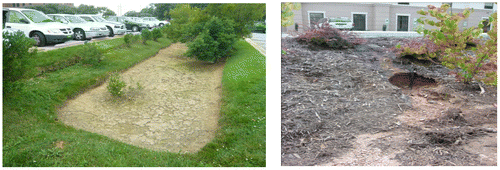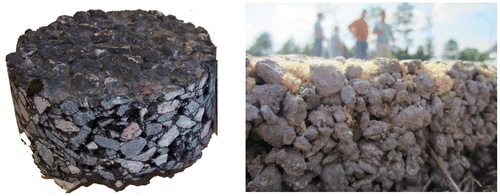Abstract
Great investment is made in the design and installation of stormwater control measures (SCMs). Substantial research investment, too, is made to optimise the performance of SCMs. However, once installed, SCMs often suffer from lack of maintenance or even outright neglect. Key maintenance needs for wet ponds, constructed stormwater wetlands, bioretention, infiltration practices, permeable pavement, swales, and rainwater harvesting systems are reviewed with many tasks, such as the cleaning of pre-treatment areas and the preservation of infiltration surfaces, being common maintenance themes among SCMs. Consequences of lacking maintenance are illustrated (mainly insufficient function or failure). Probable reasons for neglect include insufficient communication, unclear responsibilities, lack of knowledge, financial barriers, and decentralised measures. In future designs and research, maintenance (and lack thereof) should be considered. Assessing the performance of SCMs conservatively and including safety factors may prevent consequences of under-maintenance; and requiring regular inspection may help to enforce sufficient maintenance.
1. Introduction
Stormwater management systems are being installed world-wide to curb impacts due to urbanization such as flooding, stream degradation, nutrient delivery and eutrophication of lakes and estuaries, and other contamination of waterways (Blecken et al., Citation2012; Groffman et al., Citation2004; Walsh et al., Citation2005). Fletcher et al. (Citation2014) describe the various nomenclature that has been ascribed to these systems (including best management practices (BMPs), stormwater control measures (SCMs), sustainable urban drainage systems (SUDS)) and implementation strategies (e.g., water sensitive urban design (WSUD), low impact development (LID), and green infrastructure (GI)). Herein, the term SCM is used. Research teams continue to improve upon the base designs of practices in order to optimise performance of SCMs; in recent years numerous studies have been conducted on that topic. Examples of design advancement include the inclusion of submerged zones or internal water zones in bioretention (Brown et al., Citation2011a; Zinger et al., Citation2013), the choice of plant species and filter materials for bioretention (Read et al., Citation2008; Zhang et al., Citation2008), substitution of boutique media for the gravel base course of permeable pavement (Wardynski et al., Citation2013), the creation of predictive models for practices such as swales (Deletic & Fletcher, Citation2006), and real-time controlled discharge of water from rainwater harvesting systems (DeBusk et al., Citation2014).
All of these design improvements and tools are predicated upon some basic assumptions: these SCMs will be constructed and maintained appropriately. Though, often, after their construction, SCMs are either forgotten (Al-Rubaei et al., Citation2013; Bergman et al., Citation2011; Hunt et al., Citation2011; Lindsey et al., Citation1992) or assumed to work indefinitely by stormwater managers. However, if proper construction and/or maintenance are neglected for these SCMs, the refinements in design may be meaningless.
It seems that for many managers of stormwater systems, there is an expectation that once constructed, SCMs will function well without any oversight. Would one build a waste water treatment plant (WWTP) and then abandon that system, in hopes that the WWTP will simply work sans oversight? The answer to this question is no; similarly appropriate construction and maintenance must also be performed for SCMs. But the question itself must be applied to SCMs and their (lack of) operation and maintenance. This article (1) reviews maintenance needs and maintenance neglect reported in previous studies world-wide and (2) reports the authors’ research experience including field studies of numerous SCMs in Sweden and North Carolina, USA, inter alia, focusing on their long-term performance and maintenance needs. The literature was reviewed using the databases scopus and web of science with the search terms “maintenance” and “long-term performance” in combination with the different SCMs. Based on the identified maintenance needs and documented neglect we discuss barriers and drivers for proper maintenance, options for regulators to facilitate satisfactory performance of SCMs, and research needs.
2. Common maintenance oversights for SCMs
The most common maintenance needs for several SCMs used world-wide are summarized in Table and presented and discussed herein. In general the practices are given in order of descending surface area (and catchment size). A specific focus is placed on post-construction SCMs. All practices discussed share a common maintenance need: access for personnel to the SCM site and the required equipment. Although this appears to be obvious, Hirschman & Woodworth (Citation2010) found that 14% of nearly 200 evaluated SCMs in Virginia, USA, did not have maintenance access. An inspection of 30 municipal stormwater ponds in five Swedish municipalities conducted by the authors in 2013 showed that nine of these ponds did not have access for inspection and maintenance but were surrounded by fences without gates. Twenty six ponds could, with some effort (e.g. climbing over the fence), be accessed by foot, five were not accessible at all (unpublished data).
Table 1. Common maintenance elements of stormwater control measures.
2.1 Wet ponds/sedimentation basins
Wet ponds, also termed wet detention basins and sedimentation basins, are one of the most common and longest-tenured SCMs used in wetter regions worldwide (Figure ). Design of wet ponds is predicated upon providing sedimentation to pollutants, by capturing an entire design storm’s volume and then retaining this water for multiple-day release through an outlet structure (Persson, Citation2000). A specific design element for ponds is the forebay, a pool located at the point where concentrated runoff enters the pond.
Figure 1. Example wet ponds in North Carolina, USA (with forebay in foreground), Singapore, New Zealand, and Sweden (clockwise from top left).

Wet ponds and related basins have two principal inspection and maintenance needs: (1) excavation of sediment from the forebay and (2) preservation of outlet function. Surveys of the Sweden-wide pond upkeep mentioned previously of 26 ponds aged between 3 years and 33 years included assessment of their general condition (inlet and outlet structures, erosion, etc.), sediment and litter accumulation at inflow and outflow structures, vegetation condition and evidence of waste dumping. The surveys revealed that no regular maintenance had been carried out for these ponds during their operation life (ranging from 3–33 years). Fourteen ponds needed maintenance, mainly due to sediment and litter accumulation at inflow and outflow points. However, there was no evidence of dumping in any pond, and all but two were free of debris. All but one pond were in good condition with respect to the inlet and outlet structures, where damage of the outlet structure was noticed, causing the water level to be below that designed.
Similarly, Starzec et al. (Citation2005) reported that 50% of 26 ponds owned and operated by the national Swedish road administration lacked a documented maintenance program and concluded that this threatened their long-term function. The importance of maintenance is underlined by several studies. Erosion of pond sediment may occur after the pond’s capacity is expended and/or if stormwater follows non-uniform internal flow paths (Persson, Citation2000). Downstream ecosystem health impairment is possible due to pollution found in pond sediment. A large percentage of the metals in sediment are in potential mobile forms and pond sediment can display a toxic response (Karlsson et al., Citation2010; Marsalek & Marsalek, Citation1997). A specific examination of 30 pond and wetland forebays illustrated that certain metals frequently (up to 50% of the time) reach levels of toxicity in captured forebay sediment (McNett & Hunt, Citation2011). Maintenance of an aged stormwater pond in New York, USA, could improve the COD removal significantly (O'Connor & Rossi, Citation2007),
Commonly, dredged pond sediment is stored on land in the vicinity of the facility for drying/dewatering to reduce its weight before final disposal (Graham & Lei, Citation2000). However, since the chemical phase distribution of metals in sediments is significantly affected by drying and trace metal availability increases during aeration of previously anoxic sediments (Stephens et al., Citation2001), the drying/dewatering that occurs during the disposal may lead to an increase in metal mobility especially considering that a large percentage of metals is in potentially mobile fractions (Camponelli et al., Citation2010). Thus, the leachate from the dredged sediment may contain significant metal concentrations (Karlsson et al., Citation2010). Nevertheless, leachate is commonly re-discharged to the pond, which probably implicates that these SCMs do not reduce the environmental impact of stormwater discharges, but merely postpone it; further research regarding these issues is recommended. Consequently, sedimentation-based treatment facilities must be maintained in such a way that the metals remain in the sediment while in the pond, with the sediment being removed under controlled conditions so that the potentially mobile metals are not released.
Forebays are a key design feature of wet ponds, as they serve as the intended location for deposition of coarse and gross solids, as well as larger soil particles (Figures and ). Using rules-of-thumb, forebays have been sized to comprise 10% of a pond’s surface area, which has been found to be generally adequate (Johnson, Citation2007). The shape and location of forebays is intended to allow excavation of trapped solids and sediment. Disposal of sediment is potentially costly. McNett and Hunt (Citation2011) found some of 30 forebays to contain potentially toxic levels of Zn and Cu (other metals tested were below toxicity thresholds) to aquatic life. Relative to other studies conducted by VanLoon et al. (Citation2000) and Heal et al. (Citation2006) where sediment from the entire pond were sampled, forebay sediments appeared to be generally less contaminated, presumably due to the fact that nearly all the accumulated matter was coarse. Metal concentrations in the excavated soils were sufficiently low so that the soil could be land applied and seeded.
Figure 2. Common wet pond maintenance needs. Top left to right: forebay excavation; outlet/overflow clogging. Bottom left to right: Storage of sediment in the vicinity of the pond which is a risk for leaching of metals during de-watering/drying; disposal of dredged sediment at a landfill in Sweden.
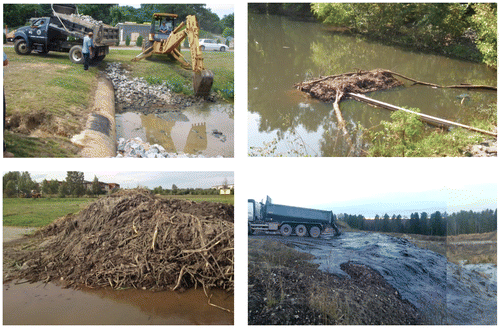
Outlets, which are frequently designed to detain fractions of runoff for multiple days after a storm, are prone to clogging (Hunt et al., Citation2011). This is due to two principal causes: (1) relatively small orifices create the detention and (2) wet ponds and wetlands “produce” a substantial portion of flotsam (Figure ). This is a problem shared by constructed stormwater wetlands and further discussed in the following section. Common wet pond maintenance tasks are illustrated in Figure .
2.2 Constructed stormwater wetlands (CSWs)
Stormwater wetlands provide a hybrid between large detention facilities like wet ponds and green infrastructure-based technologies (utilising vegetation and soil for stormwater treatment). Most of a constructed stormwater wetlands’ (CSWs) footprint is dominated by shallower water zones that provide for full coverage of the SCM by emergent vegetation. The water-vegetation-soil matrix provides multiple pollutant treatment mechanisms including gross solid filtration, biological transformation, and some sorption (Greenway, Citation2004). CSWs are pock marked by smaller deep pools, notably at the inlets; these deep pools (or if at the inlets, forebays) are intended sedimentation zones (McNett & Hunt, Citation2011). Images of CSWs are provided in Figure .
Figure 3. Example wetlands in New Zealand (from outlet structure), California (forebay to left) and Sweden (with sinuous flowpath). Bottom right photo: courtesy of Växjö municipality.
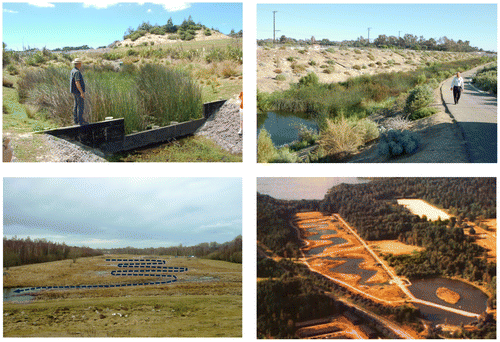
Three principal maintenance issues have been observed with CSWs: (1) sediment and solid accumulation in the forebays (as discussed in the wet pond section), (2) clogging of the outlet structure by debris, and (3) the creation of mosquito habitat due to undesirable vegetation. Some of these problems have been documented in literature, as Hunt et al. (Citation2011) described a pair of wetlands in Australia and the United States that had neglected outlet structures, leading to elevated water tables in each. In Australia, the outlet accumulated debris and rubbish, which was never removed as part of routine maintenance, elevating the wetland’s water level by nearly 0.5 m, drowning most of the vegetation. Consequently, vegetated coverage declined from nearly 50% to essentially nothing.
Unchecked vegetation establishment and growth can lead to colonization of the CSW by vegetation prone to harbouring mosquitoes. Greenway et al. (Citation2003) and Hunt et al. (Citation2006) demonstrated that the arrival and presence of Typha spp. and certain tree species like Salix nigra both positively correlated with mosquito populations. Asset managers in response to public health concerns face criticism and danger if CSWs in their jurisdiction become mosquito breeding grounds due to risk of disease (Gingrich et al., Citation2006). Designers could account for the proliferation of undesirable vegetative species by aggressively planting species they know to be conducive to both rapid growth and attracting mosquito predators. Species such as Pontedaria cordata and Sagittaria latifolia are used in North America for this reason (Hunt & Lord, Citation2006).
Harvesting of vegetation may become an important driver for CSW maintenance, particularly in locations where nutrient sequestration and removal are regulatory requirements. The above ground mass of nitrogen in vegetation species common in stormwater wetlands were shown to account for approximately 20–25% of annual influent nitrogen in stormwater runoff (Lenhart et al., Citation2012). If further research shows that removal of this vegetation effectively decreases the amount of N and P discharged to receiving waters, harvesting could become common. Also, improving CSW’s metal treatment performance by using hyperaccumulating plant species has been shown to be promising (Fritioff & Greger, Citation2003; Weiss et al., Citation2006). However, decomposition of plant litter may re-release pollutants to the water column (Chimney & Pietro, Citation2006), again arguing for the potential harvest of vegetation. Further, disposal of this vegetation and the accompanying underlying soil is nuanced. Fast growing plant species could be utilised as energy crops (as e.g. suggested by Idris et al. (Citation2012) for Giant Reed (Arundo donax) from waste water treatment wetlands). However, possible contamination has to be taken into account.
Al-Rubaei et al. (Citation2014) and Merriman and Hunt (Citation2014) compared water quality data collected in CSWs in Sweden and North America, respectively, after each CSW had aged 19 and 5 years, respectively. Both practices had never been maintained during that time. They reported some enhanced nutrient and metal removal after aging, assumingly due to maturation (establishment of vegetation and accompanying treatment processes). Thus, the beneficial effect of harvesting of vegetation must be weighed against potential drawbacks of the act of harvesting causing possible damage to the CSW, impacting biological and chemical treatment processes.
Similar to pond sediment (see previous), dewatering of dredged sediment may lead to conditions favouring metal release from the sediment and has thus to be handled with care. Common CSW maintenance tasks are illustrated in Figure .
2.3 Bioretention cells (BRCs)
Bioretention systems, also referred to as biofiltration, bioinfiltration, and rain gardens, are vegetated filters that allow water to pass through a vegetated media prior to discharge by underdrains, infiltrating, or evapotranspiration. The vegetation and underlying filter media subject multiple pollutant processes to the runoff including sorption, physical straining, sedimentation, biological transformation, desiccation, and heat exchange (Blecken et al., Citation2011; Hunt et al., Citation2012). A diagram and images of bioretention cells are found in Figure .
Figure 5. Bioretention cells in North Carolina (top left), Australia (top right) and Sweden (the latter with a small sediment forebay, bottom left) and a cross section of bioretention.
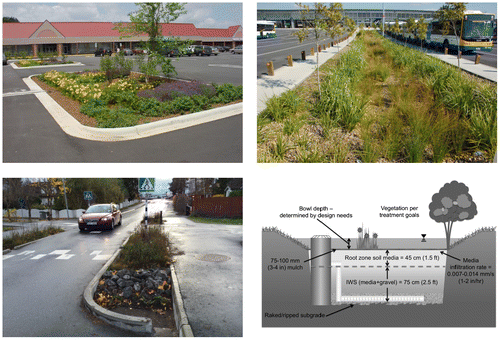
Principal maintenance activities for bioretention include: (1) vegetation upkeep, (2) inspecting and cleaning the inlet and overflow structure, and (3) preserving the surface infiltration rates of the surface media. Since vegetation plays an important role for the treatment processes and supports to maintain the infiltration capacity (Le Coustumer et al., Citation2012; Read et al., Citation2008), healthy and well established vegetation is essential for BRCs. Thus, especially in the first one-two-year establishment period, vegetation replanting and removal of weeds and dead plants is important. When employed, sediment forebays must be cleaned regularly.
The overflow structure requires regular inspection. Litter build-up can block the structures and has to be removed (as discussed for CSWs). If the outlet structure is broken or set at a wrong elevation, no ponding is provided and the water is directly conveyed to the bypass and thus not treated.
Wardynski and Hunt (Citation2012) surveyed the maintenance needs of 43 bioretention cells in North Carolina, USA. They found that more than one-half of the cells had maintenance deficiencies with the most common problem being surface clogging, often due to internal erosion caused by concentrated flow along the perimeter of the bioretention cells (Figure ).
If a BRC fails to infiltrate satisfactorily due to clogging, a complete reconstruction of all or part of the cell may be necessary (Asleson et al., Citation2009; Brown & Hunt, Citation2012).
2.4 Infiltration trenches
If the in-situ conditions are suitable for infiltration (e.g., rather coarse underlying soil, sufficient distance between surface and groundwater table), the volume and magnitude of stormwater discharges can be substantially reduced. Infiltration trenches are commonly located along roadways (Figure ).
Figure 7. Left: Infiltration trench covered with concrete grid pavers along a residential road in Sweden. An apparent clogging risk due to sand applied during winter maintenance is present. Right: Sediment removal from (inter alia) infiltration trenches and buffers strips.

However, clogging due to accumulation and deposition of sediments on the infiltration trench surface over time can reduce their effective life-span severely (Borgwardt, Citation2006; Dietz, Citation2007); some systems functioned for only a few years. Lindsey et al. (Citation1992) have shown that simple inspection and maintenance of stormwater infiltration facilities in Maryland, USA, was not sufficient and that their long-term function failed. Bergman et al. (Citation2011) examined two infiltration trenches in Copenhagen, Denmark, and reported that clogging of the trench surfaces led to more overflows and prevented the trenches from functioning as intended. Evaluating 12 infiltration trenches in Sweden, Al-Rubaei et al. (Citation2015) reported that 11 of these sytems did not work as designed due to clogging and/or contruction errors. One of the trenches was severely clogged due to leaf litter from surrounding trees after only 1.5 years of operation (Figure ).
Figure 8. Newly constructed and later clogged infiltration trench surface covered with interlocking concrete pavers.
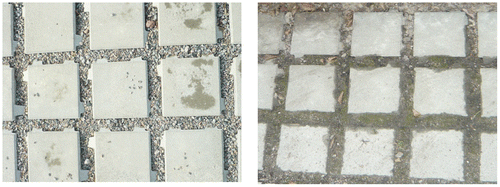
Thus, a preventative maintenance measure for infiltration trenches is the prevention or (at least) minimisation of both sediments and leaf detritus from collecting on the surface of the infiltration facility (e.g., sand from winter road maintenance, sediment from construction sites, and overhanging tree litter-fall). Fach et al. (Citation2011) evaluated the winter performance of infiltration trenches and reported a reduced infiltration capacity at sites where snow including gravel and fines was dumped on the system. Pre-treatment (e.g. by buffer strips) reduces the sediment load entering the system. Figure illustrates the risk of sediment entering an infiltration trench from a road surface when a buffer strip is lacking.
If there is evidence of surface clogging, fines need to be removed. In contrast to permeable pavements (discussed next), vacuum cleaning may not be possible at infiltration trenches due to lack of accessibility for street sweepers . When infiltration trenches are topped by permeable paving systems, gravel media loss (due to vacuuming) can be problematic. Clogging remedies include: removal of the top layer, tilling of the infiltration surface and/or mechanical removal of sediment prior to accumulating on the pavement. In Luleå, Sweden, after each winter most roadways and (vegetated) adjacent buffer strips, swales and infiltration surfaces are mechanically cleaned using loader-mounted rotating sweepers (Figure ).
2.5 Permeable pavement
Permeable pavement, also termed porous pavement, is a hardscape that supports vehicular traffic while allowing runoff to pass through the surface, where it is stored in an underlying gravel storage layer for subsequent infiltration, discharge by underdrainage system or combination of both. Permeable pavement subjects runoff to gross filtration, sedimentation, heat exchange, and with design modifications modest amounts of sorption (Drake et al., Citation2013). Cross-sections and images of permeable pavement are found as Figures and .
Figure 10. Several examples of permeable pavement types in Connecticut, Sweden, Denmark, and Illinois (clockwise from top left).
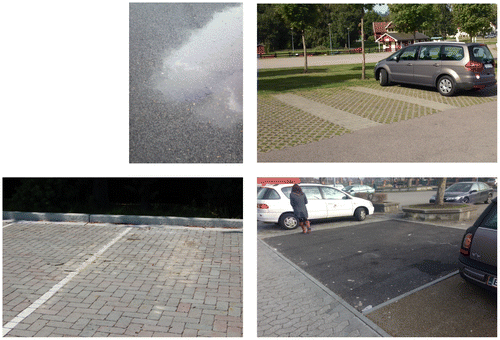
Similar to infiltration trenches, the main threat for an efficient long-term function of permeable pavements is clogging due to lack of maintenance which has been commonly observed in various long term studies (Bean et al., Citation2007; Drake et al., Citation2013). Evaluating the hydraulic function of 18- and 24-year old porous asphalt in Northern Sweden, Al-Rubaei et al. (Citation2013) observed infiltration rates >95% lower than the original conditions.
Vacuum cleaning could be used for recovering of the infiltration capacity of clogged permeable pavements. While most studies have been limited to small-scale testing, recently Drake and Bradford (Citation2013) and Al-Rubaei et al. (Citation2013) have investigated the effect of vacuum cleaning on clogged permeable pavements in field in Canada and Sweden, respectively. Vacuum cleaning could (only) partially restore the infiltration capacity of the systems which (in one of the Swedish cases) enabled the infiltration of relatively intense Swedish design storms (return interval = 100 years, duration >10 min). However, in both studies, a large spatial variability of the post-cleaning infiltration capacities was observed; preventative vacuum-cleaning is thus recommended. Despite partial restoration, clogging leads to irreversible decreases in permeability (Drake et al., Citation2013). Thus, to ensure an effective long term function of permeable pavements by the preventative reduction of clogging, regular vacuum cleaning (in combination with high pressure washing) is recommended (Al-Rubaei et al., Citation2013; Baladès et al., Citation1995; Drake et al., Citation2013; Pezzaniti et al., Citation2009).
Several maintenance studies on permeable pavement have tested alternative ways to dislodge sediment that causes blinding, including the use of pressure washers on the surface of permeable concrete (Coughlin et al., Citation2012; Dougherty et al., Citation2011) and reverse flushing (Shirke & Shuler, Citation2009). Both methods seem to have potential on small scale applications, as does vacuuming using an industrial vacuum, known as a shop vac (Figure ).
Figure 11. Small-scale (left) and industrial-sized (right) vacuuming of permeable pavement applications.

Several factors determine the likelihood of clogging, namely: (1) permeable pavement fronting landscape (and associated overhanging vegetation), (2) permeable / impermeable pavement interface, (3) paths of “dirty” vehicles, (4) proximity of snow disposal and local snow treatment practices, and (5) prevalence of nearby construction/ soil disturbance. Not all permeable applications are likely to clog, especially those that have limited exposure to the factors listed above.
2.6 Filter strips and swales
Perhaps the simplest and most basic of SCMs, grassed filter strips and swales convey runoff at relatively shallow depths, exposing runoff to gross filtration, (sometimes modest) infiltration with the potential for sorption, and sedimentation. Swale and filter strip use is particularly prevalent along roadways (Bäckström, Citation2003; Barrett et al., Citation1998), as is pictured in Figure . A flush kerb set-down is required and has to be maintained to allow water discharging freely from the road surface into the swale or filter strip (e.g. Figure top left, Figure ). While these systems tend to be comprised of turf grass, swales can particularly have design modifications (such as wetland planting) to improve nutrient reduction (Winston et al., Citation2012).
Figure 12. (clockwise from top left) Example swales in Germany, Sweden and Maryland, USA. A filter strip in North Carolina, USA.
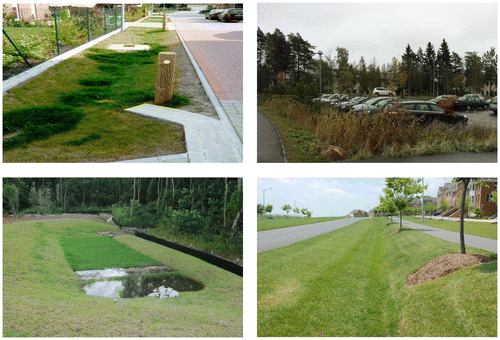
Figure 13. Rutting in soggy soil due to poorly timed mowing/ trimming of turf grass. Flush curb without set-down due to turf growth and sediment accumulation leading to water ponding and sediment accumulation on the road surface.

Most swale and filter strip maintenance needs are derived from how standard turf is managed, namely mowing or trimming of vegetation. There are, however, a couple of key differences of which practitioners must be aware. Because swales and filter strips receive runoff from catchment areas that often dwarf their own footprint, they are exposed to not only a lot more water, but also substantial amounts of water-borne nutrients. Simple calculations, for example, suggest that a standard swale in Singapore receives the equivalent of 100 kg/ha of 10-10-10 (N-P-K) fertilizer annually (Hunt et al., Citation2014). Runoff-delivered nutrients eliminate the need to fertilize these SCMs, making this stormwater landscape different from cognate ‘upland’ turf.
The nutrient delivery yields relatively rapid turf growth. Mowing or trimming turf to proper heights is important in their function to increase particle settling (Kirby et al., Citation2005). Maintaining grass heights of 100 to 150 mm has been suggested to be ideal for particulate trapping (Hunt et al., in prep). This range of turf height is taller than what is expected on most groomed landscapes, which is an important point to convey to landscape personnel.
One final difference between maintaining standard turf and maintaining turf in a filter strip or swale is timing of mowing. The stormwater landscapes are appreciably soggier than upland landscapes after modest to moderate precipitation amounts (5–25 mm). While mowing turf the day following an isolated 20 mm precipitation event would not be odd in most temperate climates, the turf in a filter strip would have been exposed to perhaps an equivalent of a 200 mm rain event or even greater. Mowing that filter strip, therefore, would be a soggy, muddy affair, which would likely result in rutting and scarring of the vegetation (Figure ).
2.7 Rainwater harvesting
Originally cast as a water supply measure, the stormwater quality benefits of rainwater harvesting have more recently been realized (DeBusk et al., Citation2013). Sedimentation in the tank provides opportunity for sediment-borne pollutants to collect at its bottom, before water is extracted for use (DeBusk et al., Citation2014; Lee et al., Citation2010). Design modifications initially seen en masse in New Zealand (North Shore City Council, Citation2009) to convert rainwater harvesting tanks into dual purpose systems (detention on top, and supply on the bottom) promise to make this practice more attractive to designers. A schematic of a RWH system and a few examples are provided in Figure .
Figure 14. Top left: Rainwater harvesting schematic. Top right and lower right: Above ground rainwater harvesting tanks in New Zealand and Australia. Bottom left: Below ground rainwater harvesting system in North Carolina, USA.

As with many SCMs, the key maintenance needs are preventing unwanted accumulation of debris and detritus in the tank. This is done using simple debris screens and what are termed ‘first flush diverters’ (Figure ). Debris screens need to be occasionally raked free of gross solids, while first flush diverters must be cleaned out.
Figure 15. A first flush diverter (left) with clean out (middle). Cleaning out a debris screen (right).
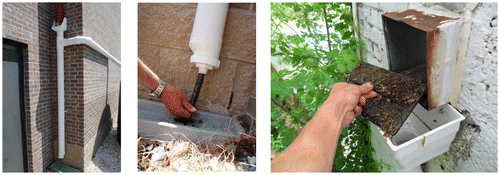
When underutilized, water stored in the tank can become odorous, leading to its even less-likely usage (DeBusk et al., Citation2014). Water in tanks should be occasionally emptied or chloride tablets be dissolved inside the tank to eliminate the smell. Ideally, for best stormwater management, the harvested water will be regularly used and odor will not become a problem.
Other system-wide maintenance needs exist as well, including separation (and consequent leaking) of conveyance piping, mechanical or electrical failures with the pump and associated appurtenances, and cleaning of filters. Typically, the more complicated the rainwater harvesting system, the more complicated and specialized the maintenance needs.
3. Financial and other barriers to conducting proper maintenance
Commonly a lack of communication exists among different stakeholders, disciplines and even different departments within a jurisdiction (Cettner et al., Citation2013; Hunt et al., Citation2011; van Herk et al., Citation2011). The successful implementation and operation of SCMs needs the contribution, close collaboration and mutual understanding of different expertise (e.g., water engineering, traffic engineering and planning, chemistry, urban planning, horticulture, ecology, and landscape architecture).
Often there is unclear ownership/responsibility for SCMs. For example, in Sweden and parts of the United States, water and waste water services (including stormwater) are paid by a water fee or utility, i.e., not by general fund tax money. The water services are not allowed to use this money for non-water specific purposes. This could, for example, include mowing the grass in an infiltration trench or swale; tasks such as these are conducted by the parks/road maintenance department which may not have a self-interest in the maintenance of SCMs. In other cases private land owners are forced by regulation to implement SCMs on their private properties. Although SCMs are often installed correctly, practical experience shows that maintenance is not performed properly due to a lack of knowledge, an absence of a sense of responsibility and/or the willingness to pay.
Maintenance issues must be taken into account early in the design process. Although this is done in many design guidelines (Moreton Bay Waterways and Catchments Partnership, Citation2006; NCDENR, Citation2009), it is often neglected in practice (e.g., as described above, a lack of maintenance access to SCMs (Figure )).
Figure 16. Wet ponds with (left) a forebay and (right) a low flow drawdown structure that have very difficult accessibility in North Carolina, USA.

Municipalities also indicate a preference toward economies of scale vis-à-vis maintenance. This is counter to the more decentralized approaches recommended by treatment regimes such as low impact development and water sensitive urban design. While it may be rather simple to inspect and maintain a few SCMs treating large catchment areas, proper maintenance of widespread decentralised SCMs requires substantially more investment, organisation and coordination.
Because many practices appear to suffer long-term and chronic maintenance due to poor construction (e.g., as documented world-wide by Brown and Hunt (Citation2011b), Greenway et al. (Citation2007) and Al-Rubaei et al. (Citation2015)), it is likely that SCM designers take an important role in construction supervision. This, however, is not likely until designers are paid to do so. When a bioretention cell clogs during construction or a CSW has an inappropriately installed orifice structure (keeping the internal water elevation too high), maintenance staff face an ‘uphill battle’ to keep a practice functioning as intended.
4. Discussion and research perspectives
Since (i) implementation of SCMs is increasing in many countries and (ii) existing practices are getting older, it is important to guarantee their adequate function in both the short- and long-term. SCMs are an investment intended to preserve stream health, improve water quality, reduce flooding, and, when possible, deliver ecosystem services (Jose et al., Citation2015; Moore & Hunt, Citation2012). When being implemented catchment-wide, SCMs can mimic the natural water cycle and reduce the discharge of pollutants (Cizek & Hunt, Citation2013; Roy et al., Citation2008). Yet, when maintenance is neglected the financial investment that was incurred with the siting, design, construction, and land/opportunity cost is wasted. Failed SCMs are a waste of money. Moreover, failed systems do not serve their purpose and thus do not contribute to a more sustainable environment. Further, we suspect that obvious failures could lead to a loss in public confidence in stormwater treatment technologies.
Arguments in favor of proper maintenance at a minimum are hydrologic, water quality and safety. In some locations, aesthetics and appearance require even more frequent maintenance activities. However, care must be taken to avoid aesthetic-based maintenance (such as fertilisation) that compromises water quality or hydrologic goals.
Until more information is known on the impacts of neglect or under-maintenance, regulators have a few options:
| (1) | Include factors-of-safety in the design of SCMs, such as requiring larger surface areas. This allows for partial failure of the SCM, while delivering the intended hydrologic and/or water quality objectives. The necessary cost of this approach is added expense in land and construction. | ||||
| (2) | Conservatively assess the performance of SCMs. For example, if research demonstrates that a properly functioning and maintained SCM reliably releases TN at a concentration of 0.90 mg/L, perhaps the regulatory authority should credit this practice with a TN effluent concentration of 1.00 mg/L. | ||||
| (3) | Require annual inspection of each SCM by a professional (e.g, engineer or landscape architect) who then provides proof and a professional assurance that the practice is operating as intended. Jurisdictions using this approach were found to have reliably better SCMs than those that did not by Wardynski et al. (Citation2012). The use of standardised check-lists is recommended to enable comparison of results. Regular inspection includes control of key structures, vegetation condition, rodent and environmental damages, sediment accumulation in ponds, and infiltration capacity measurements for permeable pavements, infiltration trenches and BRCs. Modifications of standardised procedures may be used to simplify regular testing for landscape maintenance professionals. | ||||
Obviously, any of the scenarios mentioned above require investment. But, this investment is essential to the long-term viability of SCMs and, frankly, should be accounted for in future SCM installations.
In conclusion, we think that research should also focus more on the (long-term) function of field facilities and on their maintenance to ensure sufficient performance. Research must not only focus on “showcase” SCMs and design optimization laboratory studies but also evaluate the function of existing “forgotten” systems, many of which may be more than 20 years old. Research can inform solutions for their maintenance and, if needed, restoration. Re-evaluating the first generations of aging SCMs is a chance to be seized to prepare for the ‘tidal wave’ of systems which will be built in the coming years and decades. Re-evaluation should include the identification of conditions that have led to either maintenance neglect or sufficient maintenance (such as single-purpose vs. multi-purpose design; institutions with stake in maintenance; isolated vs. visual SCM siting enabling/prohibiting regular surveillance; and winter maintenance).
Successful SCM performance and urban drainage systems are not only dependent upon well-adapted and improved design and construction practices. Long-term maintenance over the entire operation life is critical for SCM function, allowing concepts like LID, SUDS, and WSUD to create (at least hydrologically) sustainable communities.
Additional information
Funding
References
- Al-Rubaei, A.M., et al., 2013. Long-term hydraulic performance of porous asphalt pavements in northern Sweden. Journal of Irrigation and Drainage Engineering, 139 (6), 499–505.
- Al-Rubaei, A. M., Viklander, M., and Blecken, G. T. 2015. Long-term hydraulic performance of stormwater infiltration systems. Urban Water Journal, 12 (8), 660–671. doi: 10.1080/1573062X.2014.949796
- Al-Rubaei, A., et al., 2014. Removal efficiency of urban pollutants by a constructed stormwater wetland - preliminary results. In: Proceedings of the 13th International Conference on Urban Drainage, 7–12 September 2014, Kuching, Malaysia: IWA.
- Asleson, B.C., et al., 2009. Performance assessment of rain gardens. Journal of the American Water Resources Association, 45 (4), 1019–1031.
- Bäckström, M., 2003. Grassed swales for stormwater pollution control during rain and snowmelt. Water Science and Technology, 48 (9), 123–132.
- Baladès, J.-D., Legret, M., and Madiec, H., 1995. Permeable pavements: pollution management tools. Water Science and Technology, 32 (1), 49–56.
- Barrett, M.E., et al., 1998. Performance of vegetative controls for treating highway runoff. Journal of Environmental Engineering, 124 (11), 1121–1128.
- Bean, E.Z., Hunt, W.F., and Bidelspach, D.A., 2007. A Field Survey of Permeable Pavement Surface Infiltration Rates. Journal of Irrigation and Drainage Engineering, 133 3), 249–255.
- Bergman, M., et al., 2011. Evaluation of two stormwater infiltration trenches in central Copenhagen after 15 years of operation. Water Science and Technology, 63 (10), 2279–2286.
- Blecken, G.-T., Marsalek, J., and Viklander, M., 2011. Laboratory study of stormwater biofiltration in low temperatures: Total and dissolved metal removals and fates. Water, Air, and Soil Pollution, 219 (1–4), 303–317.
- Blecken, G.-T., et al., 2012. Stormwater impact on urban waterways in a cold climate: Variations in sediment metal concentrations due to untreated snowmelt discharge. Journal of Soils and Sediments, 12 (5), 758–773.
- Borgwardt, S., 2006. Long-term in-situ infiltration performance of permeable concrete block pavement. Proceedings of the 8th International Conference on Concrete Block Paving. Washington, DC: Interlocking Concrete Pavement Institute, 149–160.
- Brown, R.A., and Hunt, W.F., 2011a. Underdrain configuration to enhance bioretention exfiltration to reduce pollutant loads. Journal of Environmental Engineering, 137 (11), 1082–1091.
- Brown, R.A., and Hunt, W.F., 2011b. Impacts of media depth on effluent water quality and hydrologic performance of under-sized bioretention cells. Journal of Irrigation and Drainage Engineering, 137 (3), 132–143.
- Brown, R.A., and Hunt, W.F., 2012. Improving bioretention/biofiltration performance with restorative maintenance. Water Science & Technology, 65 (2), 361–367.
- Camponelli, K.M., et al., 2010. Chemical fractionation of Cu and Zn in stormwater, roadway dust and stormwater pond sediments. Environmental Pollution, 158, 2143–2149.
- Cettner, A., et al., 2013. Stormwater management and urban planning: Lessons from 40 years of innovation. Journal of Environmental Planning and Management, 56 (6), 786–801.
- Chimney, M.J., and Pietro, K.C., 2006. Decomposition of macrophyte litter in a subtropical constructed wetland in south Florida (USA). Ecological Engineering, 27 (4), 301–321.
- Cizek, A.R., and Hunt, W.F., 2013. Defining predevelopment hydrology to mimic predevelopment water quality in Stormwater Control Measures (SCMs). Ecological Engineering, 57, 40–45.
- Coughlin, J.P., Campbell, C.D., and Mays, D.C., 2012. Infiltration and clogging by sand and clay in a pervious concrete pavement system. Journal of Hydrological Engineering, 17 (1), 68–73.
- DeBusk, K.M., Hunt, W.F., and Wright, J.D., 2013. Characterization of rainwater harvesting performance in humid southeast USA. Journal of the American Water Resources Association, 49 (6), 1398–1411.
- DeBusk, K.M., and Hunt, W.F., 2014. Impact of rainwater harvesting systems on nutrient and sediment concentrations in roof runoff. Water Science and Technology: Water Supply, 14 (2), 220–229.
- Deletic, A., and Fletcher, T.D., 2006. Performance of grass filters used for stormwater treatment - A field and modelling study. Journal of Hydrology, 317 (3–4), 261–275.
- Dietz, M.E., 2007. Low impact development practices: A review of current research and recommendations for future directions. Water Air Soil Pollution, 186 (1–4), 351–363.
- Dougherty, M., et al., 2011. Quick surface infiltration test to assess maintenance needs on small pervious concrete sites. Journal of Irrigation and Drainage Engineering, 137 (8), 553–563.
- Drake, J.A.P., Bradford, A., and Marsalek, J., 2013. Review of environmental performance of permeable pavement systems: State of the knowledge. Water Quality Research Journal of Canada, 48 (3), 203–222.
- Drake, J., and Bradford, A., 2013. Assessing the potential for restoration of surface permeability for permeable pavements through maintenance. Water Science and Technology, 68 (9), 1950–1958.
- Fach, S., et al., 2011. Performance of infiltration swales with regard to operation in winter times in an alpine region. Water Science and Technology, 63 (11), 2658–2665.
- Fletcher, T., et al., 2014. SUDS, LID, BMPs, WSUD and more – The evolution and application of terminology surrounding urban drainage. Urban Water, doi:10.1080/1573062X.2014.916314
- Fritioff, Å., and Greger, M., 2003. Aquatic and terrestrial plant species with potential to remove heavy metals from stormwater. International Journal of Phytoremediation, 5 (3), 211–224.
- Gingrich, J.B., et al., (2006). Stormwater ponds, constructed wetlands, and other best management practices as potential breeding sites for west Nile virus vectors in Delaware during 2004. Journal of the American Mosquito Control Association, 22 2), 282–291.
- Graham, E.I., and Lei, J.H., 2000. Stormwater management pond and wetlands sediment maintenance. Water Quality Research Journal of Canada, 35 (3), 525–539.
- Greenway, M., Dale, P., and Chapman, H., 2003. An assessment of mosquito breeding and control in four surface flow wetlands in tropical subtropical Australia. Water Science and Technology, 48 (5), 249–256.
- Greenway, M., 2004. Constructed wetlands for water pollution control - processes, parameters and performance. Developments in Chemical Engineering and Mineral Processing, 12 (5–6), 491–504.
- Greenway, M., Jenkins, G., and Polson, C., 2007. Macrophyte zonation in stormwater wetlands: Getting it right! A case study from subtropical Australia. Water Science and Technology, 56 (3), 223–231.
- Groffman, P.M., et al., 2004. Nitrogen fluxes and retention in urban watershed ecosystems. Ecosystems, 7 (4), 393–403.
- Heal, K., Hepburn, D., and Lunn, R., 2006. Sediment management in sustainable urban drainage system ponds. Water Science and Technology, 53 (10), 219–227.
- Hirschman, D. J., and Woodworth, L., 2010. Design, construction, and maintenance of LID practices: Results from a field assessment in Virginia's James River watershed. Proceedings of the 2010 International Low Impact Development Conference. San Francisco, CA: Environmental & Water Resources Institute, 1075–1088.
- Hunt, W.F., et al., 2006. Occurrence and relative abundance of mosquitoes in stormwater retention facilities in North Carolina. USA. Water Science and Technology, 54 (6–7), 315–321.
- Hunt, W.F., Davis, A.P., and Traver, R.G., 2012. Meeting hydrologic and water quality goals through targeted bioretention design. Journal of Environmental Engineering, 138 (6), 698–707.
- Hunt, W.F., et al., 2011. Constructed storm-water wetland installation and maintenance: Are we getting it right? Journal of Irrigation and Drainage Engineering, 137 (8), 469–474.
- Hunt, W.F., Fassman, E.A., and Deletic, A. in preparation. Designing dry swales for stormwater quality improvement using the Aberdeen equation. Urban Water, in prep.
- Hunt, W.F. and Lord, W.G., 2006. Stormwater Wetlands and Wet Pond Maintenance. Raleigh, NC: North Carolina Cooperative Extension Service Publication AG-588-07.
- Hunt, W.F., et al.,, 2014. Plant Selection for Bioretention and Stormwater Treatment Practices. Singapore: Springer. doi:10.1007/978-981-287-245-6
- Idris, S.M., et al., 2012. Performance of the giant reed (arundo donax) in experimental wetlands receiving variable loads of industrial stormwater. Water, Air, and Soil Pollution, 223 (2), 549–557.
- Johnson, J., 2007. Evaluation of stormwater wetland and wet pond forebay design and stormwater wetland pollutant removal efficiency (M.S. Thesis). Biological and Agricultural Engineering, North Carolina State University, Raleigh, NC.
- Jose, R., Wade, R., and Jefferies, C. (2015). Smart SUDS: Recognising the multiple-benefit potential of sustainable surface water management systems. Water Science and Technology, 71 (2), 245–251.
- Karlsson, K., et al., 2010. Heavy metal concentrations and toxicity in water and sediment from stormwater ponds and sedimentation tanks. Journal of Hazardous Materials, 178 (1–3), 612–618.
- Kirby, J.T., et al., 2005. Hydraulic Resistance in Grass Swales Designed for Small Flow conveyance. Journal of Hydraulic Engineering, 131 (1), 65–68.
- Le Coustumer, S., et al., 2012. The influence of design parameters on clogging of stormwater biofilters: A large-scale column study. Water Research, 46 (20), 6743–6752.
- Lee, J.Y., et al., 2010. Comparison of the microbiological and chemical characterization of harvested rainwater and reservoir water as alternative water resources. Science of the Total Environment, 408, 896–905.
- Lenhart, H.A., Hunt, W.F., and Burchell, M.R., 2012. Harvestable nitrogen accumulation for five storm water wetland plant species: Trigger for storm water control measure maintenance? Journal of Environmental Engineering, 138 (9), 972–978.
- Lindsey, G., Roberts, L., and Page, W., 1992. Inspection and maintenance of infiltration facilities. Journal of Soil & Water Conservation, 47 (6), 481–486.
- Marsalek, J., and Marsalek, P.M., 1997. Characteristics of sediments from a stormwater management pond. Water Science and Technology, 36 (8–9), 117–122.
- McNett, J.K., and Hunt, W.F., 2011. An evaluation of the toxicity of accumulated sediments in forebays of stormwater wetlands and wet ponds. Water, Air, and Soil Pollution, 218 (1–4), 529–538.
- Merriman, L.S. and Hunt, W.F., 2014. Maintenance versus maturation: Constructed storm-water wetland’s fifth-year water quality and hydrologic assessment. Journal of Environmental Engineering, 140 (10), 05014003-1-11.
- Moore, T.L.C., and Hunt, W.F., 2012. Ecosystem service provision by stormwater wetlands and ponds - a means for evaluation? Water Research, 46 (1), 6811–6823.
- Moreton Bay Waterways and Catchments Partnership. 2006. Water Sensitive Urban Design Technical Design Guidelines for South East Queensland. Brisbane: Moreton Bay Waterways and Catchments Partnership.
- North Carolina Department of Environment and Natural Resources (NCDENR). 2009. Stormwater best management practices manual. Raleigh, NC: Division of Water Quality.
- North Shore City Council (NZ). 2009. Rain Tank Guidelines. Auckland, NZ. Retrieved from http://www.aucklandcouncil.govt.nz/EN/environmentwaste/stormwater/Documents/nsccraintankguidelines2009.pdf
- O'Connor, T. P., and Rossi, J. 2007. Monitoring of a retention pond before and after maintenance. Proceedings of the World Environmental and Water Resources Congress 2006. Omaha, NE: Environmental and Water Resources Institute, 1–11.
- Persson, J., 2000. The hydraulic performance of ponds of various layouts. Urban Water, 2 (3), 243–250.
- Pezzaniti, D., Beecham, S., and Kandasamy, J., 2009. Influence of clogging on the effective life of permeable pavements. Water Management, 62 (WM3), 211–220.
- Read, J., Wevill, T., Fletcher, T.D., and Deletic, A., 2008. Variation among plant species in pollutant removal from stormwater in biofiltration systems. Water Research, 42, 893–902.
- Roy, A.H., et al., (2008). Impediments and solutions to sustainable, watershed-scale urban stormwater management: Lessons from Australia and the United States. Environmental Management, 42 (2), 344–359.
- Shirke, N.A., and Shuler, S., 2009. Cleaning porous pavements using a reverse flush process. Journal of Transportation Engineering, 135 (11), 832–838.
- Starzec, P., et al., 2005. Technical and environmental functioning of detention ponds for the treatment of highway and road runoff. Water, Air, and Soil Pollution, 163 (1–4), 153–167.
- Stephens, S.R., et al., 2001. Changes in the leachability of metals from dredged canal sediments during drying and oxidation. Environmental Pollution, 114, 407–413.
- Van Herk, S., et al., 2011. Learning and action alliances for the integration of flood risk management into urban planning: A new framework from empirical evidence from the Netherlands. Environmental Science and Policy, 14 (5), 543–554.
- VanLoon, G., et al., 2000. Characterizing stormwater Sediments for ecotoxic risk. Water Quality Research Journal of Canada, 35 (3), 341–364.
- Walsh, C.J., et al.,, 2005. The urban stream syndrome: Current knowledge and the search for a cure. Journal of the North American Benthological Society, 24 (3), 706–723.
- Wardynski, B.J., and Hunt, W.F., 2012. Are bioretention cells being installed per design standards in North Carolina? A field study. Journal of Environmental Engineering, 138 (12), 1210–1217.
- Wardynski, B.J., Winston, R.J., and Hunt, W.F., 2013. Internal water storage enhances exfiltration and thermal load reduction from permeable pavement in the North Carolina mountains. Journal of Environmental Engineering, 139 (2), 187–195.
- Weiss, J., et al., 2006. Laboratory study of heavy metal phytoremediation by three wetland macrophytes. International Journal of Phytoremediation, 8 (3), 245–259.
- Winston, R.J., et al., 2012. Field Evaluation of Stormwater Control Measures for Highway Runoff Treatment. Journal of Environmental Engineering, 138(1), 101–111.
- Zhang, W., Brown, G.O., and Storm, D.E., 2008. Enhancement of heavy metals retention in sandy soil by amendment with fly ash. Transactions of the ASABE, 51 (4), 1247–1254.
- Zinger, Y., et al., 2013. Optimising nitrogen removal in existing stormwater biofilters: Benefits and tradeoffs of a retrofitted saturated zone. Ecological Engineering, 51, 75–82.


